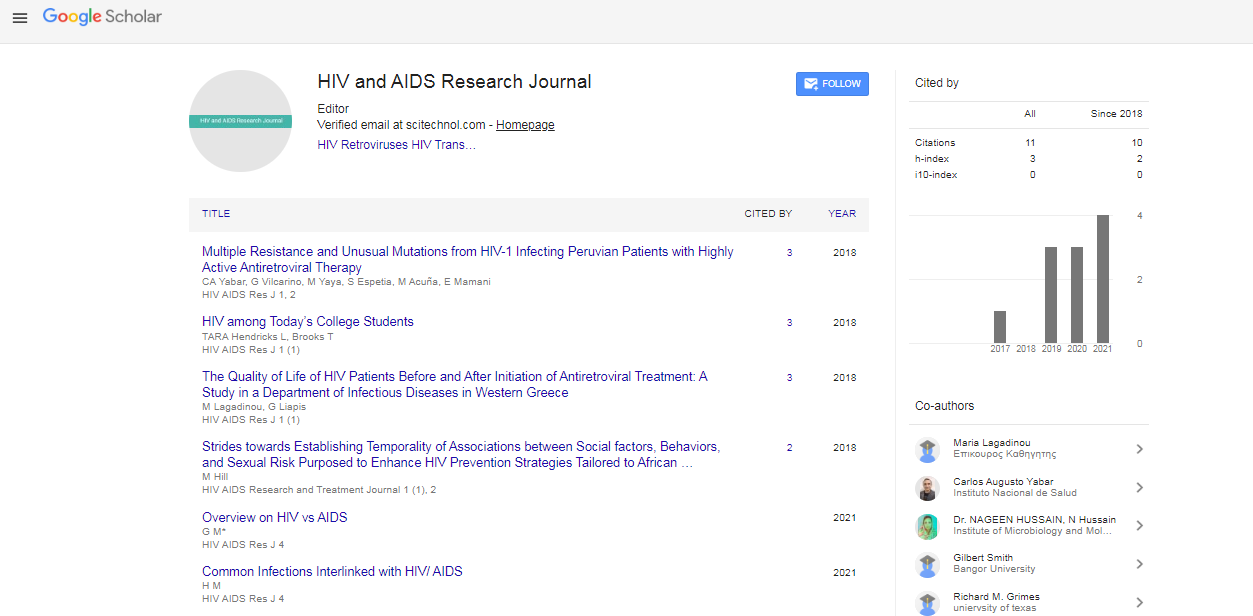Perspective, Hiv Aids Res J Vol: 6 Issue: 4
Advancements in HIV Clinical Therapies: Managing Infection, Improving Lives
Carlos Peter*
1Department of Public Health Medicine, University of KwaZulu-Natal, Durban, South Africa
*Corresponding Author: Carlos Peter,
Department of Public Health Medicine,
University of KwaZulu-Natal, Durban, South Africa
E-mail: petercarlos@uni.edu
Received date: 04 December, 2023, Manuscript No. HARJ-24-124119;
Editor assigned date: 06 December, 2023, PreQC No. HARJ-24-124119 (PQ);
Reviewed date: 20 December, 2023, QC No. HARJ-24-124119;
Revised date: 28 December, 2023, Manuscript No. HARJ-24-124119 (R);
Published date: 05 January, 2024 DOI: 10.4172/Harj.1000133
Citation: Peter C (2024) Advancements in HIV Clinical Therapies: Managing Infection, Improving Lives. HIV AIDS Res J 6:4.
Description
The landscape of Human Immunodeficiency Virus (HIV) clinical therapies has undergone remarkable evolution since the discovery of the virus. Antiretroviral Therapy (ART) stands as the cornerstone of HIV management, significantly altering the course of the disease and improving the quality of life for individuals living with HIV.
Antiretroviral Therapy (ART)
Antiretroviral therapy stands as the cornerstone of HIV management. ART comprises a combination of antiretroviral drugs from various classes, eachtargeting distinct stages of the HIV life cycle. These classes include:
Nucleoside Reverse Transcriptase Inhibitors (NRTIs): Drugs like tenofovir and emtricitabine inhibit the activity of reverse transcriptase, impeding the conversion of viral RNA into DNA.
Non-Nucleoside Reverse Transcriptase Inhibitors (NNRTIs): Medications such as efavirenz and rilpivirine bind to and inhibit reverse transcriptase, preventing viral replication.
Protease Inhibitors (PIs): Drugs like darunavir and atazanavir block the action of the viral protease, halting the maturation of infectious viral particles.
Integrase Inhibitors (INSTIs): INSTIs, including dolutegravir and raltegravir, target the integrase enzyme, impeding the integration of viral DNA into the host cell genome.
Adjunct therapies
Beyond ART, adjunct therapies play a pivotal role in enhancing HIV management:
Pre-Exposure Prophylaxis (PrEP): PrEP involves the use of the antiretroviral medications by HIV-negative individuals at high risk of acquiring HIV, significantly reducing the risk of infection.
Post-Exposure Prophylaxis (PEP): PEP involves the immediate use of antiretroviral drugs after potential exposure to HIV, reducing the likelihood of infection.
Treatment of Opportunistic Infections: Managing and preventing opportunistic infections, such as tuberculosis and certain fungal and bacterial infections, is crucial in individuals with compromised immune systems due to HIV.
Challenges in therapy
Despite the efficacy of antiretroviral therapies, several challenges persist:
Drug resistance: Prolonged use of antiretroviral drugs can lead to the development of drug-resistant strains of HIV, necessitating the use of alternative medications.
Adherence issues: Strict adherence to the medication schedules is critical for the success of ART. Factors such as pill burden, side effects, and social determinants can affect adherence levels.
Viral reservoirs and latency: HIV can establish latent reservoirs in the body, rendering the virus impervious to antiretroviral drugs and immune responses, posing challenges for complete eradication.
Novel therapeutic approaches and future directions
Ongoing research focuses on the innovative strategies to complement existing therapies and overcome current limitations:
Long-acting formulations: Developing long-acting injectable or implantable formulations aims to improve treatment adherence by reducing the frequency of dosing.
Broadly neutralizing antibodies: These antibodies exhibit promising potential in preventing HIV infection and suppressing viral replication, offering a novel approach to therapy.
Functional cure and remission strategies: Investigating therapeutic approaches aimed at achieving sustained viral suppression without lifelong treatment represents a significant area of interest in HIV research.
Conclusion
Antiretroviral therapy has transformed HIV infection from a once life-threatening condition to a manageable chronic disease. However, the challenges such as treatment adherence, drug resistance, and side effects persist. Continued research endeavors focused on novel therapeutic approaches, such as long-acting formulations, immunotherapies, and strategies aiming for a functional cure, hold promise in enhancing treatment efficacy and improving the lives of individuals living with HIV.
 Spanish
Spanish  Chinese
Chinese  Russian
Russian  German
German  French
French  Japanese
Japanese  Portuguese
Portuguese  Hindi
Hindi 